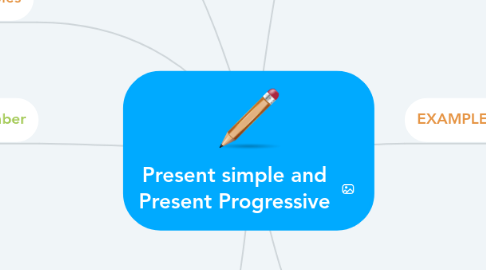
1. The present simple is used:
1.1. For habitual or repeated actions, usually with adverbs of frequency : I always get up early in the morning
1.2. For permanent situations int he present : Susan lives in France
1.3. For actions related to timetables and programmes: the train to Oxfors leaves at 7:30 pm
1.4. For general truths: Whales live in the sea
2. Examples
2.1. Present progressive: they are looking at their books Present simple: They read a lot
2.2. Present progressive: He is eating an ice- cream Present simple: He likes ice- cream
3. Remember
3.1. I- WE-YOU- THEY: read - like - work - live - watch- do- have
3.2. HE- SHE- IT : reads- likes works - lives - watches - does - has
4. The present simple structures are:
4.1. Positve Sentences
4.1.1. SUBJECT + VERB + COMPLEMENT
4.1.1.1. Tim works very hard. he starts at 7: 30 and finished at 8 o´clock in the evening
4.1.1.2. The Earth goes round the sun
4.1.1.3. We usually work on sunday
4.2. Negative Sentences
4.2.1. SUBJECT + DO/ DOES+ NOT + VERB+ COMPLEMENT
4.2.1.1. I drink cofee but I do not drink tea
4.2.1.2. Sandra speaks Spanish but she does not speak Italian
4.2.1.3. you do not work hard
4.2.1.4. Petter does not play the piano very well
4.3. Interrogative Sentences
4.3.1. DO/ DOES + SUBJECT+ VERB+ COMPLEMENT + ?
4.3.1.1. Do your friends live near hear?
4.3.1.2. Does Susan play tennis every saturday ?
4.3.1.3. Do you always have breakfast ?
5. The present progressive is used:
5.1. For actions or events happening at or around the time of speaking: He is talking on the phone now
5.2. For temporary states in the present: Peter is looking for a job
5.3. Future actions related to personal arrangements. The time is mentioned: I am giving a party tonight
5.4. For annoying repeated actions, with adverbs of frequency such as always, continually etc: She is always talking in class
6. EXAMPLES
6.1. She is eating. She is not reading
6.1.1. The weather is nice at the moment. It is not raining
6.1.1.1. You can turn off the television. I am not watching it.
6.2. It is raining. The sun is not shining
6.2.1. Please be quiet. I am working ( =I am working now)
6.2.1.1. Look at Sue! she is wearing her new hat (= she is wearing it now)
6.3. They are running. They are not walking
6.3.1. "where are the children? "They are playing in the park"
6.3.1.1. (on the phone) we are having dinner now. Can you phone again later?
7. GRAMMAR STRUCTURES
7.1. POSITIVE SENTENCES
7.1.1. subjet + am/ is / are + doing / eating / running writing etc.+ complement
7.2. NEGATIVE SENTENCES
7.2.1. subject + verb to be + not + verb ing + complement
7.3. INTERROGATIVE SENTENCES
7.3.1. verb to be + subject + verb ing + complement + ?

